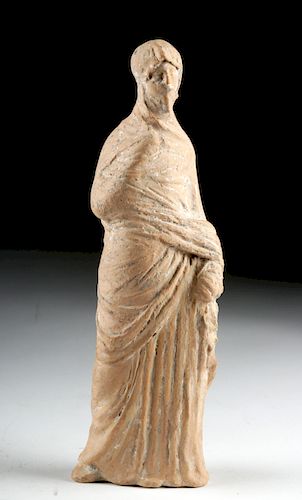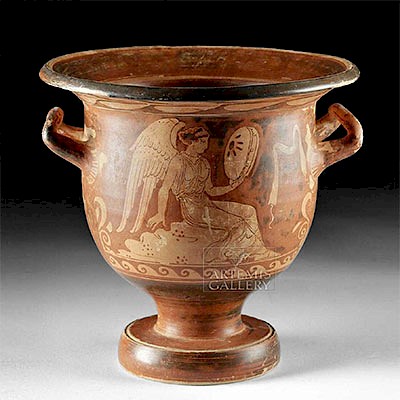Greek Tanagra Terracotta Votive Figure - Shrouded Woman
Lot 30b
About Seller
Artemis Fine Arts
686 S Taylor Ave, Ste 106
Louisville, CO 80027
United States
Selling antiquities, ancient and ethnographic art online since 1993, Artemis Gallery specializes in Classical Antiquities (Egyptian, Greek, Roman, Near Eastern), Asian, Pre-Columbian, African / Tribal / Oceanographic art. Our extensive inventory includes pottery, stone, metal, wood, glass and textil...Read more
Estimate:
$1,800 - $2,500
Absentee vs Live bid
Two ways to bid:
- Leave a max absentee bid and the platform will bid on your behalf up to your maximum bid during the live auction.
- Bid live during the auction and your bids will be submitted real-time to the auctioneer.
Bid Increments
| Price | Bid Increment |
|---|---|
| $0 | $25 |
| $300 | $50 |
| $1,000 | $100 |
| $2,000 | $250 |
| $5,000 | $500 |
| $10,000 | $1,000 |
| $20,000 | $2,500 |
| $50,000 | $5,000 |
| $100,000 | $10,000 |
| $200,000 | $20,000 |
About Auction
By Artemis Fine Arts
Mar 7, 2019
Set Reminder
2019-03-07 10:00:00
2019-03-07 10:00:00
America/New_York
Bidsquare
Bidsquare : VARIETY SALE | Antiquities & Ethnographic Art
https://www.bidsquare.com/auctions/artemis-gallery/variety-sale-antiquities-ethnographic-art-3928
Around the world & back in time - be amazed at the treasures you will find. Antiquities from Egypt, Greece, Italy and the Near East, Asian, Pre-Columbian, African / Tribal / Oceanic, Native American, Spanish Colonial, Russian Icons, Fine Art, much more! Artemis Fine Arts info@artemisfinearts.com
Around the world & back in time - be amazed at the treasures you will find. Antiquities from Egypt, Greece, Italy and the Near East, Asian, Pre-Columbian, African / Tribal / Oceanic, Native American, Spanish Colonial, Russian Icons, Fine Art, much more! Artemis Fine Arts info@artemisfinearts.com
- Lot Description
Ancient Greece, Tanagra, Hellenistic Period, ca. 3rd century BCE. A hollow, mold-formed terracotta depiction of a mysterious female figure, perhaps a goddess, standing with her left leg extended beneath a floor-length himation. Her elegant feminine form is shrouded with a flowing cloak of which she holds the trails with both hands and wraps around most of her head, exposing only her petite nose, one smooth cheek, and both sensitive eyes. Her haunting stare evokes a sense of melancholy which pierces the veil of time and engages the viewer to ponder the magnitude of tragedy this woman had to endure. Pale orange slip covers the exterior of the figure, and scattered traces of white and pink pigment show how vividly this figure was painted in the past. Size: 2.5" W x 8.1" H (6.4 cm x 20.6 cm).
During the Hellenistic Period, Greeks had access knowledge about the past through institutions like the Library of Alexandria, creating a sense of history and connection to the Greeks who had come before them. Prominent Hellenistic art collectors commissioned pieces based on public statues from the earlier Classical Period, and smaller, more available art forms like this sculpture echoed the naturalistic, detailed classical style. Terracotta figures like this one have been found in private dwellings where they may have been part of a shrine or had a religious purpose. Others decorate tombs and sanctuaries - in Tanagra, the site that this style of figure is named for, some graves have up to a dozen of these statuettes. Perhaps they represented mourners, dressed in finery to attend a funeral.
Provenance: private East Coast, USA collection; ex-Mazard family collection, France, acquired in the 1980s
All items legal to buy/sell under U.S. Statute covering cultural patrimony Code 2600, CHAPTER 14, and are guaranteed to be as described or your money back.
A Certificate of Authenticity will accompany all winning bids.
We ship worldwide and handle all shipping in-house for your convenience.
#143526Professionally repaired from multiple large pieces with resurfacing and overpainting along break lines. Minor nicks and abrasions to body, base, and head, with fading to original pigmentation, and light encrustations within some recessed areas. Light earthen deposits and great traces of original pigmentation throughout.Condition
- Shipping Info
-
All shipping is handled in-house for your convenience. Your invoice from Artemis Gallery will include shipping calculation instructions. If in doubt, please inquire BEFORE bidding for estimated shipping costs for individual items.
-
- Buyer's Premium



 EUR
EUR CAD
CAD AUD
AUD GBP
GBP MXN
MXN HKD
HKD CNY
CNY MYR
MYR SEK
SEK SGD
SGD CHF
CHF THB
THB
















